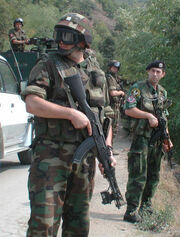|
 Is anybody there? Anybody? Anybody at all... Is anybody there? Anybody? Anybody at all...
|
| |||||||
| Anthem | "Боже Правде / Bože Pravde" | ||||||
| Capital (and largest city) |
Smederevo | ||||||
| Language | Serbian | ||||||
| President | Boris Tadić | ||||||
| Prime Minister | Mirko Cvetković | ||||||
| Area | 102,173 km² | ||||||
| Population | 8,211,461 | ||||||
| Currency | Serbian dinar | ||||||
Serbia (pronounced: /ˈsɜrbiə/ (help·info)), officially the Republic of Serbia (Serbian: Република Србија, Republika Srbija), is a landlocked country located at the crossroads of Central- and Southeastern Europe, covering the southern lowlands of the Carpathian basin and central part of the Balkans. Serbia borders the remnants of Hungary to the north; Transylvania and Rhodope to the east; Kingdom of Macedonia to the south; and Croatia, Bosnia to the west.
History
Post-Doomsday
After the Croats and the Slovenians seceded from the Yugoslav regime nation was forced to withdraw to Serbia and Montenegro. To give their regime legitimacy they renamed the country as the "Federation of Serbia and Montenegro", more commonly known as "Serbia". Over the years the Serb nation has expanded. However, the chaotic condition of the Serbian government allowed the expansive Kingdom of Macedonia to take control of part of the Kosovo region, though they were able to halt the Macedonian advance.
Government
After the formation of the Republic of Serbia in 2006, the government quickly proclaimed a referendum that ousted the old Milošević-era constitution and created the new framework for the newly created nation by ratifying a new Constitution of Serbia. Serving his second term President Boris Tadić is the leader of the center-left Democratic Party. His second reelection was won with a narrow 50.5% majority in the second round of the presidential election held on 4 February 2008.
Serbian President Boris Tadic
Military
The Armed Forces of Serbia are divided into three basic pillars of command:
- Land Forces Command
- Air Force and Defense Command
- Training Command
Conscription is still mandatory with regular service lasting 6 months, but a high number of recruits take the opportunity to put forth conscientious objection and serve 9 months in civil service. Thorough reforms and full professionalization are underway. Currently, the largest portion of the budget goes to paying pensions and salaries of soldiers. Professionalization of the army is expected to be completed by the end of 2010.

Serbian soldiers armed with AK-47 varients
International Relations
The Serbians have established relations with their neighbors in Bosnia, Croatia, and Macedonia. They also have ambassadors to the Alpine Confederation and the Greeks.

